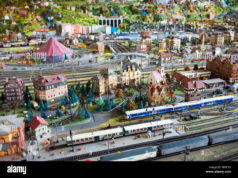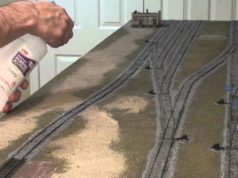During the 1920s, the model train industry was enjoying the same roaring success found in most other sections of the United States economy.
Lionel trains and other popular model railroad brands found success marketing their trains not only as toys to children, but also to adults, creating a new pastime for a country lined with households containing expendable income. At this time, most manufacturers were producing trains in O Scale, or sizes similar to its 1:48 proportions. With the onset of the Great Depression, however, the need arose for trains that were less expensive than the elaborate O Scale trains. Thus, the beginnings of HO Scale were set in place, which begins the story of the scale that currently is the most popular model train scale in the world.
The History Of HO Scale Trains
Though there had been attempts to produce a model train about half the size of O Scale (hence the name HO) as early as the 1920s, the HO scale didn’t really begin to become widely popular until after the Second World War. Even then, O Scale held its prominence in the post war economic boom until the early 1950s. HO Scale, however, was making its way into more and more markets as the desire grew for not only less expensive layouts, but also for models that would save space and be more practical for extensive home modeling. As the HO Scale was growing stronger year by year in the United States and most of Europe, Britain embraced the OO Scale. Similar to HO Scale, OO runs on the same size track, but its trains are 1:76.2 proportions, having a less accurate scale than HO. OO continues to dominate the British market today.
By the 1960s, even Lionel and other brands known for producing O Scale began to produce HO models to remain competitive in the industry. The newly dominant scale grew as it provided a middle ground for the hobby in nearly every category. It was large enough to show elaborate details, but small enough to fit an expansive layout in a spare room. HO Scale trains were less expensive than larger scales because it used less material, and cheaper than many smaller scales because of the meticulous nature of work required to accurately detail such small trains. Children liked HO Scale because it was still big enough for them to handle as a toy, and also provided the perfect size for the serious model train enthusiast who wanted to create scenes with scale accuracy.
Also helping the prominence of HO Scale was the fact that, for most manufacturers, the trains ran on more realistic looking two-rail track, as opposed to many of the previous three-rail systems. By the time HO Scale was becoming a major force in the model railroading industry, the short circuit problems that had led to the development of the three-rail system had largely been resolved. With those problems now a non-issue, many of the emerging model train enthusiasts chose HO Scale to add the realism they desired in their layouts.
And so HO Scale remains the dominant model train size in most of the world today. Nearly every major model train manufacturer produces HO Scale locomotives, railcars and accessories, making these products the most abundant of all scales. Though HO Scale was initially produced, in part, to provide a cheaper alternative to larger scales, today HO Scale trains and accessories range from inexpensive starter sets to high-end, very expensive locomotives. The wide variety makes HO Scale perfect for anyone with interest in the hobby to get started with a small initial investment, and provides them with enough expansion opportunities to make the hobby last a lifetime.






